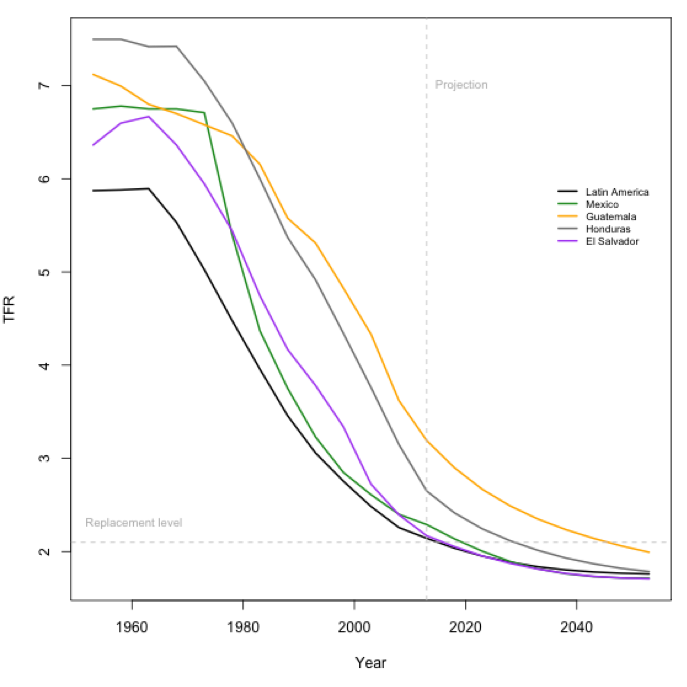Introduction
Population dynamics, often conceived only by looking at its size or volume, has defined opportunities and challenges throughout history. However, the evolution and changes of the demographic components of a population (fertility, mortality, and migration) are key for understanding the nature of these challenges and opportunities. In this document we analyze past and future demographic dynamics of the countries of the Northern Triangle of Central America (Guatemala, El Salvador and Honduras) and Mexico, the Latin American country of North America. Together, these four countries define an important social and political region, although they are not free of differences. Located at a key geographic position, Mexico has had an ambiguous identity, both as a North American and Latin American country, whereas the Northern Triangle countries have a longer history of shared cultural identity as Central American countries.
The four countries of this study differ in population size and economic development. History and geography have defined much of their current state. Political instability, violence, civil wars and coup d’états during the 1980s and 1990s in Central America defined current socioeconomic and political conditions with scars felt still today. More recently, the coup d’etat in Honduras in 2009 created a complex socio-political environment. Hurricanes (e.g. Mitch in 1998, Stan in 2005), earthquakes, and other environmental shocks also affected the NTCA countries and had health, economic, and social effects. Mexico, the richest country of the four, went through an earlier urbanization and industrialization process and, although there is diversity within the territory, economic development is higher than its southern neighbors.
What demographic trends suggest is that the four countries have experienced a rapid change driven by the decline of fertility. Moreover, they suggest that they will face challenges related to an aging society in the near future. Different from the experience of more developed countries, there are paradoxes along the process. For example, for the young population (15 to 29 years of age) the high prevalence of teenage pregnancies and the high risk of death—especially for men—illustrate the uncertainty they face when entering the adult life and anticipate adverse conditions later in their lives. At the same time, international migration seems to be no longer an option for the youth in Mexico but remains high for El Salvador, Honduras and Guatemala. The demographic data presented in this paper suggest stable trends in population dynamics for the near future for the four countries. However, these factors, along with prevailing inequality and the climate of persistent violence in the region, will determine the interaction of population dynamics with broader social change and the possible improvement of the living conditions and welfare of the population.
An Overview of Population Size and the Components of the Demographic Change in Mexico and NTCA
Population Size, Change, and Age-Structure
With a population of 168 million in 1950, Latin America represented 6.6% of the total world population, whereas in 2015 it represented 8.5% of the world’s population, with a total of 664 million. It is expected that by 2050 such share will drop to 7.9% with 779 million people. In 2015, one out of five Latin Americans lived in Mexico. Although this share is not expected to change by 2050, the Mexican population is expected to increase from 125 million to 164 million between 2015 and 2050. Interestingly, by this year, Mexico will have the same population size that Latin America had 100 years ago.
Putting numbers in context, in 2015, the total population size of the three NTCA countries was 31 million (Figure 1). This is less than one quarter of the Mexican population. Moreover, in 2015 the whole population of Central America, considering the NTCA countries along with Nicaragua, Costa Rica, Panamá and Belize, reached 46 million, and represented 7% of the Latin American population. With 6 million in 2015, El Salvador is the smallest NTCA country, followed by Honduras with 9 million and Guatemala with 16 million. By 2050, it is expected that these populations will increase to 7, 13, and 27, respectively. In addition to being the smallest country, El Salvador is the one with the smallest growth rate (below 1%) since the mid-1990s and will be zero by 2050. On the other hand, Guatemala’s growth rate is the fastest since 2005. Mexico had a fast increase in the 1960s with 3.1% but has declined to 1.2% in 2015, and is expected to decrease further. (See Figure 1)1
Another demographic dimension that needs to be analyzed jointly with population size is population structure. It refers to the sex and age distribution at a certain period of time and allows us to determine the sex balance by age and the stage of the aging process of a population at a given time. It is also useful to anticipate needs of specific age groups and to plan accordingly. Figure 2 shows the dynamics of age-structure for the four countries analyzed for the years 2015, 2030, and 2050. (See Figure 2)2
All countries are going through an aging process. However, Guatemala is the country with the youngest population today and in the coming years, followed by Honduras, Mexico, and El Salvador. Except for Guatemala, the other three countries are at the beginning of the aging process: they show an incipient reduction in the young-age groups in 2015. In 35 years (between 2015 and 2050), the population of 15 years and younger will be reduced by 13%, 20%, and 30% for Honduras, Mexico, and El Salvador, respectively. In contrast, in Guatemala this young-age group will still increase 3% in the 2015-2050 period.
Looking at this reduction in the youngest group only, it would seem that El Salvador is aging faster than the other countries. However, analyzing the change in the elderly population (aged 65 years and older) in each country, data show an increase of 3%, 3.4%, 3% and 1.3% in Guatemala, Honduras, Mexico, and El Salvador, respectively. Therefore, putting these two pieces together comparing young and old populations allows us to understand better the aging process. By 2050, there will be 110 people aged over 65 per hundred children 15 years old and younger in Mexico, whereas this is expected to be 94, 68, and 48 in Guatemala, Honduras, and El Salvador respectively. Thus, the old age dependency ratio suggests that Mexico will age faster than the other countries in the next 35 years. Moreover, the Salvadoran case shows an interesting example of how civil war scars have long-effects in sex-age structure: there is a gender imbalance with more women than men that carries over time, concentrated in those aged 50 and older in 2050.
Fertility
Since the 1950s, most Latin American countries have shown a downward trend in birthrates, together with a sustained increase in life expectancy at birth, although at different rates. The four countries that we analyze are not the exception. The total fertility rates (TFRs) of these countries are converging to the Latin American TFR (Figure 3). In 2015, El Salvador had the lowest total fertility rate3 (TFR), very close to the rest of Latin America (both equal to 2.0) and slightly lower than Mexico (2.1). In fact, TFR at El Salvador is below replacement since 2005. Honduras has a lower TFR than Guatemala since 1980.
Although we see this convergence, the explanations for fertility decline differ between countries. For example, fertility decreased in the United States, Canada and other developed countries throughout the second half of the 20th century as the result of increasing secularization and female labor force participation. In Mexico, however, this was driven by policies in the 1970s that explicitly were designed to control population growth (García Guerrero, 2014). In the NTCA countries, along with the intervention of international organizations, nongovernmental organizations (NGOs) provided free birth control and family planning information campaigns that effectively reduced fertility. By 2050, the four countries will have fertility rates below replacement level required to sustain population growth.
The rapid decrease in fertility in the four countries anticipates less demographic pressure to provide health, education, and other services to the whole population in the near future. Nonetheless, there are two pending issues that demand urgent attention. According to the prevailing socioeconomic inequality, there remain large disparities in fertility trends within the countries. For example, fertility rates and the unattended demand for contraceptives have decreased less rapidly and remain high among rural areas and indigenous populations (ECLAC-CELADE, 2014). Secondly, in spite of the changes mentioned above, the four countries show high levels of teenage fertility (PAHO-UNFPA-UNICEF, 2018; Rodriguez, 2017 and 2004). In fact, the age at first birth has stayed almost constant in time, suggesting that, differently from the experience of other countries, the decrease in fertility is not related to a delay in marriage and the arrival of the first child (Zavala and Páez, 2013; Menkes and Suárez, 2013). (See Figure 3)4
Mortality
Health has been improving in Latin America since the 1950s when health systems were created. Despite civil wars, dictatorships, and violence, the increase in life expectancy at birth5 (LE) has continued. Between 1950 and 2015, the four countries increased their male and female LE around 30 years (Figure 4). Guatemala, Honduras, and El Salvador increased their female LE more than 30 years, slightly more than Mexico with an increase of 27 years. For the case of male LE, the increase in the NTCA was lower than for females: male LE increased more than 30 years in Honduras, whereas in the other countries it did so by 27 years. Mexico had the lowest increases because it started with higher LE than the other countries. In general, this is the case for countries that transition from high mortality rates from infectious diseases to lower mortality rates driven by chronic-degenerative diseases. For example, more developed countries started in 1950 with a female LE of 67 years and male LE of 62 years, reaching in 2015 a female LE of 81 years and male LE of 75 years, such that the increases in female and male LE were 14 and 13 years; a smaller increase than Mexico and the NTCA countries.
Projections suggest that female and male LE will increase between 2015 and 2050, around 6 and 8 years, respectively. The country with the highest LE for men and women is Mexico. This is true since the 1950s and is expected to continue in the future. The main cause of this improvement in survivorship in the region is driven by the reduction of infant mortality. In 1950, there were around 128 deaths of newborn children per thousand births in Latin America. In Mexico, 121 deaths of newborn per thousand births occurred in the same year; lower levels than in Guatemala, Honduras, and El Salvador where these infant mortality rates6 (IMR) were 168, 169, and 150. These figures changed dramatically by 2015. Mexico reported an IMR of 16, Guatemala of 22, Honduras 24, and El Salvador 14. Therefore, El Salvador had the fastest decline of infant mortality since 1950, (around 90%), although the rest of the countries also had a significant decrease of around 86%. By 2050, it is expected that Mexico will have an IMR close to the Latin American average (7), El Salvador will have an IMR below the Latin American average (6) and Honduras and Guatemala will remain with the higher IMRs than the average (10 and 8, respectively). Although the progress in infant mortality has been large, the four countries are still lagging behind compared to other countries in Latin America and in 2050 they will not have reached yet the levels of infant mortality of countries such as Japan, Finland and Italy, who have today IMRs below 4. This fact illustrates that the four countries are at least three decades behind compared to the progress reported in other regions in the world. (See Figure 4)7
In addition, there are two unusual changes in the mortality trends. First, El Salvador showed a stagnation of its male LE between 1975 and 1985 possibly due to the civil war and violence. Second, Honduras showed a faster increase of male and female LEs than the rest of the countries before 2000, but it suddenly slowed down after 2005. During the 1990s, Honduras’ male LE was higher than the Latin American average.
Another factor influencing mortality, especially among men, in the four countries are homicides due to violence, especially drug and gang-related violence. According to UN data, the rate at which Mexican LE has been historically increasing (Figure 4) changed in 2005 but still remained growing and above the Latin American average. However, other studies have shown that Mexican male and female LE has stagnated and, for men, has actually decreased since 2006. This effect is attributed to the increase of homicides related with organized crime driven by the war on drugs initiated by President Calderón in 2007 (Canudas-Romo, García-Guerrero and Echarri, 2014, Canudas-Romo et al, 2016 and Aburto et al 2017). If this is found for Mexico, we expect similar effects of violence on the LE for the other NTCA countries where homicide rates have been higher and have changed more abruptly than in Mexico over time (see Figure 5)8, particularly since 2000 (Williams, 2016).
Violence and insecurity do not impact everyone alike. Young men (between 15 and 29 years of age) show the highest rates of deaths due to homicides (Canudas-Romo, García-Guerrero and Echarri, 2014; Mendoza, 2018; Williams, 2016). Future gains in LE, especially for men, will be largely defined by how the four countries deal with violence and how effective they are in decreasing the risk of death due to homicides among their young populations.
International Migration
Mexico and the NTCA are considered emigration countries and have significant shares of their nationals living abroad, primarily in the United States. According to the 2017 revision of the United Nations DESA International Migrant Stock Data, there were 15.6 million people from Mexico (12.6 million) and the NTCA (Guatemala 940,000, Honduras 630,000 and El Salvador 1.4 million) living in U.S. Together, they account for about a third of the foreign-born population in United States. From the perspective of the sending countries, this means that the population living abroad represents 10% of Mexico’s population, 6% for Guatemala, 6.5% for Honduras and 22% for El Salvador. Migration is the most uncertain component of demographic dynamics and the hardest to measure. However, based on the projections of the expected population growth, different studies point out to a future deceleration of emigration from the four countries (Hanson and McIntosh, 2016).
Figure 6 shows the net migration—that is, the balance between the total number of people that emigrated and immigrated to/from a given country—for five-year periods from 1950 to 2050. The period with the highest emigration was notably between 1995 and 2005. Net migration in 2000-2005 represented a loss of almost 3 million people for Mexico, but the greatest losses of population for the NTCA occurred earlier: -402,000 in 1995–2000 for Guatemala, -326,000 in 1995–2000 for El Salvador, and -78,000 in 1990–1995 for Honduras. These periods of largest negative net migration coincide with periods of high emigration to the United States due to political turmoil in Central America and labor-driven migration from Mexico.
For all countries, net migration changed dramatically in the 2005–2010 period. This was due to a huge decline in emigration from these countries, as well as an increase in return migration from the United States driven by economic hardship after the 2008-2009 Great Recession and an increase in deportations and immigration enforcement. For Mexico, the observed net migration of almost -3 million in 2000-2005 reduced itself almost ten times and reached less than -300,000 in the 2010–2015 period. In the coming future, levels around this net migration are expected to remain stable for Mexico. This means that total net migration of Mexico still will be dominated by emigration, and it will be close to 50,000 people per year, considering emigrants to all countries of the world as well as arrivals both from Mexican returnees and foreign-born immigrants.
In contrast with the ten-year period of low outmigration from Mexico, the NTCA still shows changes in the size of the flows. El Salvador is the NTCA country with the highest projected negative net migration, expected to change from -202,000 in 2015–2020 to -116,000 by 2045–2050. In the same periods, Guatemala and Honduras are expected to have a similar trend, changing from -46,000 to -34,000 and -14,000 to -2,000, respectively. When compared with recent data on migration flows from the NTCA to United States, we find divergent trends compared to Mexico. The flows have been increasing in the past three years and are close to the high levels observed before the Great Recession (D’Vera Cohn, Passel and Gonzalez-Barrera, 2017). However, when analyzed on a long-term perspective as the one shown in Figure 6, projections suggest stability and even a trend towards a decrease in the size of the outmigration flows.
The population in Latin America is highly mobile. We can trace dynamic intrarregional flows and persistent migration to Europe and to North America. The specificity of Mexico and the NTCA is the concentration in United States as the main destination of migrants. In 2017, more than 90% of the Mexican population living abroad was in the United States. For Guatemala, Honduras, and El Salvador, the percentages were 87.3%, 83%, and 89.3% respectively. To a certain extent, this fact has two advantages. It allows us to use U.S. sources—which are frequent and reliable—to get a broad and immediate sense of changes in migration. On the other hand, it may facilitate the search of alternatives towards a regular, ordered and documented migration.
One additional remark has to do with the changing profile of international migrants. While it remains as a very young population— most of the first-time migrants are between 15 and 29 years of age—they come more often from urban areas compared to twenty years ago, and their educational attainment is higher than prior generations. (See Figure 6)9
Finally, another specific characteristic of the region is the constant in-transit migration from the NTCA through Mexico. Beyond what the media points out every day, in transit migration through Mexico has been persistent for decades. Recent data suggest that we are close to reaching the peak high numbers of in transit migration observed in 2005, right before the Great Recession (Rodriguez, 2016), which coincides with the estimates on the increase in the flows to the United States (D’Vera Cohn et al, 2017). In addition, the flows show the increasing participation of women and children—accompanied and unaccompanied—which pose a challenge in terms of the orderly management of this type of migration. Aside from reasons related to labor opportunities and the demographic pressure, this flow is highly motivated by the political instability and the climate of violence in the NTCA. Thus, the motivation to leave their countries will persist as long as the political context at the national and local conditions remain without change.
Emerging Challenges in a Context of Persistent Inequalities
The four countries analyzed here were studied because they are part of the surrounding neighborhood of North America. Mexico is the only Latin American country of North America. Because of its geographic location, its size, and its socio-cultural ties, linked with both, United States and the rest of Latin America, it is a key piece in the region. The NTCA countries are, on the other hand, the first neighbors in the southern border of North America. The NTCA has been tied with Mexico and the United States in many ways. Moreover, they have been providing an important amount of labor force in many economic sectors, especially in the United States but also in Mexico.
Mexico and the NTCA, as many other of the countries in Latin America, have gone through a dramatic change in the population dynamics. Nobody challenges the success in the four countries in bringing down fertility and mortality rates, which occurred simultaneously with advancements in educational attainment and in other health indicators. Nonetheless, these changes occur parallel to the persistence of social, political and economic old inequalities and uncertainties. Thus, the four countries face at the same time the challenges of a new demographic dynamic and the persistence of social and economic gaps from the past.
Regarding the population dynamic, the four countries have entered, or will enter in the near future, and at different paces, the transition into aging societies. This is also true for Latin America as a region: its aging process will occur in a context of low fertility, a slowing down in survivorship (by different reasons) and a dynamic international mobility. All this is happening at the same time that challenges to improve the wellbeing and respond to the needs of a young population have not been met yet but—on the contrary—persist. The youth faces very disadvantageous scenarios as shown by the prevalent high teenage fertility rate and the high mortality due to homicides for young men. These two facts will also determine how the young cohorts of today will age.
The demographic pressure for migration has been declining, but as long as the uncertainty and the context of political turmoil and unrest persist, young people from the NTCA will have an incentive to migrate mainly to the United States and, probably and to a less extent, to Mexico. We can expect that flows will remain at the levels that we are seeing today (as high as before the Great Recession). Interestingly and in contrast, outmigration from Mexico has stabilized and has a large component of documented migration that has increased since 2008, and includes citizens, legal residents and migrants with temporary work and study visas (Giorguli-Saucedo, García-Guerrero & Masferrer, 2016). In addition, and probably with a different face than before, family ties, social networks, and the economic relations between Mexico and the United States anticipate that mobility between both countries will be a constant in the short and medium term.
An example of the new face of Mexico-U.S. migration can be traced in the flows from the United States to Mexico. Migration to Mexico has transformed itself, due to changes in the characteristics and the number of Mexicans that are returning from the north, as well as the number of foreign-born immigrants, especially U.S. born children under age, who have arrived to Mexico since the Great Recession (Masferrer 2018). Still, Mexico can hardly be considered a country of immigration. Around 1 percent of the population is foreign-born, and this contrasts sharply with the 14 percent observed in the United States, or the 20% in Canada. For Central Americans, Mexico does not seem to be an option as a destination. It remains an open question whether this will change in the future, but—as long as the climate of violence prevails in the NTCA—Mexico should be prepared for an increasing number of arrivals, driven not only by economic factors but in search of refuge and asylum.
Silvia Giorguli-Saucedo is the president of El Colegio de México (COLMEX). Víctor M. García-Guerrero and Claudia Masferrer are professors at the Center for Demographic, Urban, and Environmental Studies at El Colegio de México (CEDUA-COLMEX).
Supporting Data
Figure 1. Total past and projected population, 1950-20501

Figure 2. Past and projected population age-sex structure, 2015, 2030, 20502

Figure 3. Past and projected total fertility rate, 1950-20504

Figure 4. Past and projected life expectancy at birth, 1950-20507

Figure 5. Intentional homicides per 100,000 people by sex, 2000-20158

Figure 6. Past and projected net migration (in millions) for five-year periods, 1950-20509

References
Aburto, José Manuel, H Beltrán-Sánchez, VM García-Guerrero y V Canudas-Romo (2016). “Homicides in Mexico Reversed Life Expectancy Gains for Men and Slowed Them for Women, 2000-10”, Health Affairs 35(1):88-95. DOI: 10.1377/hlthaff.2015.0068
Canudas-Romo, Vladimir, JM Aburto, VM García-Guerrero y H Beltran-Sánchez (2016). “Mexico’s Epidemic of Violence and its Public Health Significance on Average Length of Life”, Journal of Epidemiology & Community Health. DOI:10.1136/jech-2015-207015
Canudas-Romo, Vladimir, VM García-Guerrero y CJ Echarri-Canovas (2014). “The stagnation of the Mexican male life expectancy in the first decade of the 21st century: the impact of homicides and diabetes mellitus”, Journal of Epidemiology & Community Health, 69:1 28-34, DOI:10.1136/jech-2014-204237
Cohn, D., Passel, J., & Gonzalez-Barrera, A. (2017). Rise in US Immigrants from El Salvador, Guatemala and Honduras Outpaces Growth from Elsewhere: Lawful and Unauthorized Immigrants Increase Since Recession. Pew Research Center.
Economic Commission for Latin America, Latin American and Caribbean Center of Demography (2014). Los Pueblos indígenas en América Latina. Avances en el ultimo decenio y retos pendientes para la garantía de sus derechos, United Nationas-ECLAC, Santiago de Chile, Chile.
García-Guerrero, Víctor M. (2018). “Demographic Trends and International Migration in North and Central America”, Canadian Diversity/Diversité canadienne, 15:2, pp. 5-10
García Guerrero, Víctor Manuel (2014). Projections and Population Policies in Mexico, Centro de Estudios Demográficos, Urbanos y Ambientales, El Colegio de México, A.C.
Giorguli-Saucedo, Silvia, V.M. García-Guerrero, y C. Masferrer (2016). A migration system in the making: Demographic dynamics and migration policies in North America and the Northern Triangle of Central-America. Centro de Estudios Demográficos, Urbanos y Ambientales, El Colegio de México A.C Retrieved from http://cedua.colmex.mx/images/_micrositios/amsitm/Giorguli_Garcia_Masferrer_2016.pdf
Hanson, G., & McIntosh, C. (2016). Is the Mediterranean the new Rio Grande? US and EU immigration pressures in the long run. Journal of Economic Perspectives, 30(4), 57-82.
Masferrer, Claudia. (2018). “Return Migration from the United States to Mexico: New Challenges of an Old Phenomenon,” Canadian Diversity/Diversité canadienne, 15:2, pp. 23-30
Masferrer, Claudia, VM García Guerrero y S. Giorguli (2018). “Connecting the Dots: Emerging Migration Trends and Policy Questions in North and Central America”, Migration Policy Institute.
Mendoza, Carlos (2018). Inform on Homicide Violence in Guatemala, Dialogos-Open Society Foundation, Guatemala.
Menkes, Catherine and L. Suárez (2013). “El embarazo de los adolescentes en México: ¿Es deseado?”, Coyuntura Demográfica, Núm. 4, pp. 21-28.
Pan American Health Organization, United Nations Population Found and UNICEF (2018). Accelerating progress toward the reduction of adolescent pregnancy in Latin America and the Caribbean, Washington D.C., EE.UU.
Rodríguez, E. (2016). Central American Migrants in Irregular Transit through Mexico: new figures and trends. CANAMID Policy Brief Series #14: CANAMID. Retrieved from http://canamid.org/en
Rodriguez, Jorge (2017). “Deseabilidad y planificación de la fecundidad adolescente en América Latina y el Caribe: tendencias y patrones emergentes”, Notas de Población, Num. 104, pp. 119-144
Rodriguez, Jorge (2004). “La fecundidad alta en el Istmo Centroamericano: un riesgo en transición”, Población y Salud en Mesoamerica, Vol. 2, Num. 1, pp. 1-32
United Nations, Department of Economic and Social Affairs, Population Division (2017). World Population Prospects: The 2017 Revision, DVD Edition.
United Nations, Department of Economic and Social Affairs, Population Division (2017). International Migrant Stock Data: The 2017 Revision, DVD Edition.
United Nations Office on Drugs and Crime (2018). International Homicide Statistics Database. Retrieved from https://data.worldbank.org/indicator/VC.IHR.PSRC.P5
Williams, Rebecca (2016). Youth Violence and Citizen Security in Central America’s Northern Triangle, Innovation for Agricultural Training and Education, USAID.
Zavala, Ma. Eugenia and O. Páez (2013). “El retraso en la salida de la escuela no pospone la maternidad en México”, Coyuntura Demográfica, Núm. 4, pp. 13-19.
















